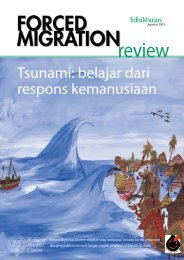FMR 42 full issue pdf - Forced Migration Review
FMR 42 full issue pdf - Forced Migration Review
FMR 42 full issue pdf - Forced Migration Review
You also want an ePaper? Increase the reach of your titles
YUMPU automatically turns print PDFs into web optimized ePapers that Google loves.
<strong>FMR</strong> <strong>42</strong><br />
Sexual orientation and gender identity and the protection of forced migrants 7<br />
The fifth is that of ‘disbelief’ – which often<br />
goes hand-in-hand with stereotyping. Not<br />
all courts accept the self-identification of the<br />
applicant as LGBTI. Some ask for witness<br />
statements or documentation such as emails,<br />
ignoring the fact that this might be impossible<br />
for the applicant to produce, in particular<br />
when he or she has been doing everything<br />
possible to hide their sexual orientation.<br />
Developing guidance<br />
UNHCR has developed policy and<br />
practical guidance for staff, partners, state<br />
authorities and decision-makers to promote<br />
a consistent and rights-based approach<br />
to the protection of LGBTI people.<br />
In 2008 UNHCR <strong>issue</strong>d a Guidance Note<br />
on Refugee Claims Relating to Sexual<br />
Orientation and Gender Identity 4 to improve<br />
decision-makers’ awareness about the specific<br />
experiences of LGBTI asylum seekers and<br />
encourage a deeper analysis of the legal<br />
questions involved. This Guidance Note is<br />
now superseded by a new set of guidelines<br />
on international protection, published in<br />
October 2012, which for the first time deal<br />
comprehensively with refugee claims based<br />
on sexual orientation and/or gender identity.<br />
These new Guidelines 5 provide advice on<br />
substantive, procedural, evidentiary and<br />
New UNHCR SOGI Guidelines<br />
Guidelines on International Protection No 9:<br />
Claims to Refugee Status based on Sexual<br />
Orientation and/or Gender Identity within the<br />
context of Article 1A(2) of the 1951 Convention<br />
and/or its 1967 Protocol relating to the Status<br />
of Refugees: available online at<br />
www.unhcr.org/509136ca9.html<br />
A new set of guidelines on international protection –<br />
superseding the Guidance Note on Refugee Claims<br />
relating to Sexual Orientation and Gender Identity<br />
(2008) – was <strong>issue</strong>d by UNHCR in October 2012.<br />
The Guidelines complement the UNHCR Handbook<br />
and Guidelines on Procedures and Criteria for<br />
Determining Refugee Status (re<strong>issue</strong>d in 2011).<br />
Other materials on sexual orientation and gender<br />
identity can be found on the Special Feature on<br />
Sexual Orientation and/or Gender Identity on<br />
Refworld at www.unhcr.org/refworld/sogi.html<br />
credibility <strong>issue</strong>s relating to such claims.<br />
The Guidelines are intended to provide<br />
guidance to governments, legal practitioners,<br />
decision-makers and the judiciary, as well as<br />
to UNHCR staff adjudicating these claims<br />
under the 1951 Convention, and to ensure<br />
a proper and harmonised interpretation<br />
across jurisdictions of the definition of a<br />
refugee under the 1951 Convention. They<br />
recognise that people fleeing persecution<br />
for reasons of their sexual orientation and/<br />
or gender identity can qualify as refugees<br />
under Article 1A(2) of the 1951 Convention.<br />
In 2011 UNHCR released a Need to Know<br />
Guidance Note on Working with Lesbian,<br />
Gay, Bisexual, Transgender and Intersex<br />
Persons in <strong>Forced</strong> Displacement 6 to help<br />
UNHCR and partners’ staff improve their<br />
understanding of the rights and the distinct<br />
vulnerabilities of LGBTI refugees and<br />
promote concrete actions to ensure that they<br />
are protected throughout all stages of their<br />
displacement. It provides practical advice<br />
on how to make office environments more<br />
welcoming, make programmes safe for, and<br />
inclusive of, LGBTI persons, and promote<br />
participation. In addition, UNHCR’s Age,<br />
Gender and Diversity Policy 7 explicitly refers<br />
to LGBTI refugees and asylum seekers.<br />
However, policy and guidance will be of<br />
limited effect if prejudice and ignorance<br />
prevail among those responsible for<br />
implementing that guidance. To remedy lack<br />
of understanding among UNHCR’s as well<br />
as partners’ staff, 8 UNHCR is developing<br />
a staff training package with ORAM. 9 This<br />
package covers terminology, responses to<br />
day-to-day protection <strong>issue</strong>s, refugee status<br />
determination (RSD) and LGBTI-sensitive<br />
interviewing techniques. The refugee status<br />
determination and resettlement processing<br />
phases are often the stages when LGBTI<br />
persons of concern will self-identify but are<br />
also where the most vital decision-making<br />
concerning their future will occur.<br />
The 2011 UNHCR Resettlement Handbook<br />
provides guidance on the resettlement of<br />
LGBTI individuals, which is often the only




